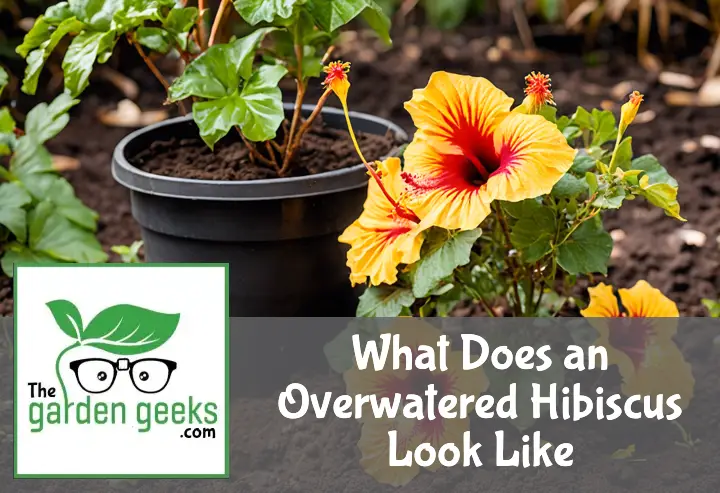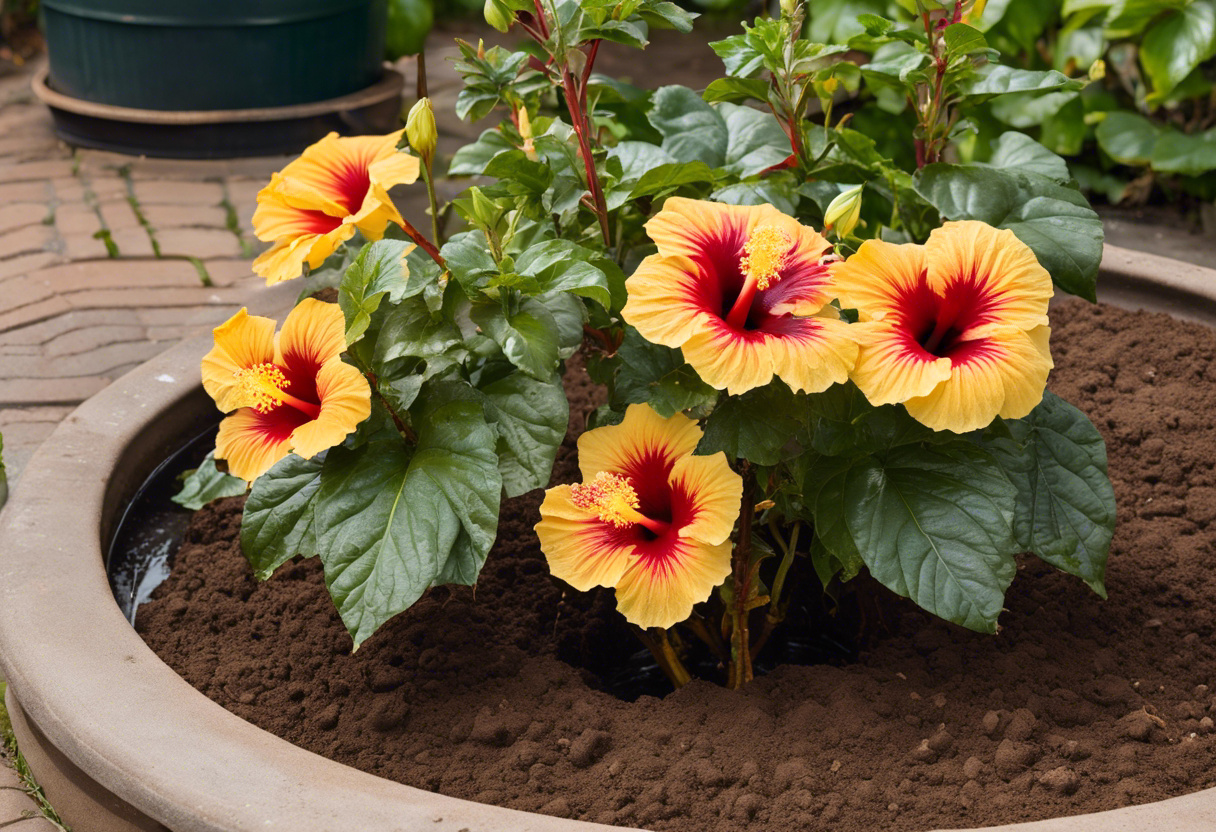Ever seen a hibiscus plant that looks like it’s had one too many drinks? Yeah, me neither until I stumbled upon an Overwatered Hibiscus in my own garden. It was a sight for sore eyes, let me tell you.
In this post, we’re going to dive into the world of overwatered hibiscus plants. So buckle up and keep reading about ‘What Does an Overwatered Hibiscus Look Like?’ You might just save your favorite flower from drowning!
Key Takeaways
- An overwatered hibiscus plant will exhibit signs such as yellowing leaves, leaf drop, and wilting.
- The plant may also show signs of root rot, which includes blackened roots and a foul smell.
- Overwatering can lead to the growth of fungus or mold on the plant.
- If not corrected, overwatering can eventually kill the hibiscus plant.
- To save an overwatered hibiscus, reduce watering frequency and ensure proper drainage.
Understanding Hibiscus Watering Needs
When it comes to hibiscus care, getting the watering right is crucial. Like Goldilocks, your hibiscus doesn’t want too much or too little water – it wants it just right. And trust me, an overwatered hibiscus isn’t a pretty sight.
Ideal Watering Conditions for Hibiscus
So, what’s the magic formula for watering hibiscus? Well, there’s no one-size-fits-all answer. It depends on factors like climate and soil type. But generally speaking, you should aim to keep the soil consistently moist.
Now, don’t confuse ‘moist’ with ‘soggy’. Your hibiscus ain’t a fan of wet feet! The goal is to avoid letting the soil dry out completely between waterings. This helps maintain a balance that promotes healthy growth and keeps your plant happy.
The best time to water? Early morning or late evening when temperatures are cooler. This reduces evaporation and ensures your hibiscus gets all the hydration it needs without wasting water.
Common Mistakes in Watering Hibiscus
Alright, let’s talk about some common boo-boos in hibiscus plant needs. Overwatering is a biggie – it can lead to root rot and other nasty issues.
Under-watering isn’t great either – it can stress your plant out and stunt its growth. So remember, consistency is key here!
Another common mistake? Not adjusting your hibiscus watering schedule based on weather conditions. If it’s hot and dry, your hibiscus might need more frequent watering. On cooler or rainy days, you can ease up a bit.
In short: pay attention to your plant and its environment. With a little observation and care, you’ll avoid an overwatered (or under-watered) hibiscus and keep your plant in blooming good health!
Identifying Overwatered Hibiscus
Watering hibiscus plants is a bit of an art form. Too little and they’ll wilt, too much and you’ve got yourself an overwatered hibiscus. It’s like Goldilocks, but with plants! The key is spotting the overwatered hibiscus symptoms early on. You know, those telltale signs your plant is screaming “I’m drowning here!”
Visual Signs of Overwatering
First off, let’s talk color. If your hibiscus leaves are going from a vibrant green to a sickly yellow, that’s not just them trying out a new look. Nope, those are yellowing hibiscus leaves, one of the classic signs of overwatering. And if the leaves or flowers start drooping like they’ve had a really tough day? That’s another sign you might be dealing with an overwatered plant.
Physical Changes in the Plant Due to Overwatering
Now onto the physical stuff. Overwatering can cause some pretty gnarly changes in your hibiscus plant. We’re talking soft stems that feel more like mush than wood – yuck! This could be due to root rot in overwatered plants or simply from too much water making everything go soft. And if your plant seems stunted or isn’t growing as it should? That could be another symptom of overhydration. So remember folks, when it comes to watering your hibiscus plant – less can often be more!
Effects of Overwatering on Hibiscus Health
Overwatering can be a real party pooper for your hibiscus. It’s like inviting someone to a buffet and they eat all the food, leaving nothing for you. That’s what an overwatered hibiscus does – it takes in too much water, leading to hibiscus water damage. This excess water can cause some serious issues with the root system and overall plant growth.
Impact on Root System
When you overwater a hibiscus, its roots become the main victims. They end up looking like they’ve had way too much to drink at a party – swollen and soggy. This is known as hibiscus root rot, one of the most common overwatered hibiscus symptoms.
The roots get so waterlogged that they start to suffocate. Yes, plants need air too! And when they don’t get enough, it leads to root damage in hibiscus plants.
Long-term consequences? Well, let’s just say it ain’t pretty. The roots can become so damaged that they stop absorbing nutrients properly. This means your once vibrant hibiscus could start looking more like a Halloween decoration than a beautiful garden addition.
Consequences for Overall Plant Growth and Flower Production
Now let’s talk about how overwatering affects the rest of the plant. Imagine trying to run a marathon with weights tied to your ankles – that’s what an overwatered hibiscus has to deal with.
The excess water causes stunted growth in overwatered hibiscus, making them look like they’re forever stuck in their awkward teenage phase.
And remember those beautiful flowers that made you fall in love with hibiscuses in the first place? Well, overwatering can lead to hibiscus flower drop due to overwatering. That’s right, your plant could start shedding flowers like a dog sheds fur in summer.
In the long run, you might even notice reduced flowering in waterlogged plants. So instead of a vibrant flower show, you’ll be left with a sad, flowerless hibiscus. And nobody wants that!
Differentiating Between Overwatered and Underwatered Hibiscus
When it comes to hibiscus care, knowing the difference between overwatering and underwatering is crucial. These two conditions may seem similar, but they’re as different as night and day.
Comparing Symptoms of Both Conditions
An overwatered hibiscus often shows signs like yellowing leaves, root rot, and a general lack of vigor. The plant might look like it’s drowning – because it is! On the other hand, an underwatered hibiscus will have wilted leaves that feel dry to the touch. It’s like your plant just ran a marathon in the desert without a water bottle!
The key here is balance. Too much water can drown your plant, while too little can leave it parched. So next time you’re about to give your hibiscus a drink, remember Goldilocks – not too much, not too little, but just right!
Misdiagnosis: Is it Really Overwatering?
Now let’s talk about misdiagnoses. Sometimes we mistake other issues for overwatering. For instance, nutrient deficiencies or pests can cause similar symptoms. It’s easy to jump to conclusions when your beloved hibiscus starts looking under the weather.
But before you start adjusting your watering routine, take a closer look at your plant. Are there any bugs lurking around? Does the soil need more nutrients? Remember that watering issues are just one piece of the hibiscus plant care puzzle.
So next time you see those telltale signs of distress in your hibiscus, don’t panic! Take a deep breath and remember these tips. With a bit of detective work and some tender loving care, you’ll have your hibiscus back in bloom in no time!
How to Save an Overwatered Hibiscus
When your hibiscus is drowning in water, it’s time for some overwatered hibiscus recovery action. Saving a waterlogged hibiscus isn’t rocket science, but it does require some tender love and care. Let’s dive into the immediate steps you need to take and how to prevent overwatering in the future.
Immediate Steps to Take
First things first, you gotta drain excess water from hibiscus. It’s like giving your plant a life jacket in a sea of water. Next up is rescuing your overwatered hibiscus, which involves removing any rotten roots or leaves that are beyond saving.
Now, don’t just stop there! You’ve got to provide some immediate care for your waterlogged plant. Think of it as first aid for your overwatered hibiscus. This could involve moving the plant to a warmer location or adjusting its light exposure.
Long-term Care and Prevention Strategies
Once you’ve navigated the stormy waters of overwatering damage control, it’s time to focus on the calm seas ahead with some hibiscus long-term care tips. Maintaining healthy hibiscus plants is all about balance – not too much water, not too little.
Preventing overwatering in plants can be as simple as using a watering schedule or investing in a self-watering pot. Remember, sustainable watering practices for hibiscus are key here!
And there you have it folks! With these tips under your belt, you’ll be well on your way to becoming an expert at preventing overwatering in your beloved hibiscus plants.
To Wrap Up
Just like Goldilocks, your hibiscus doesn’t want its water too much or too little – it has to be just right! Overwatering can turn your vibrant beauty into a wilting wallflower. So, keep an eye out for yellow leaves, root rot, and leaf drop.
Don’t let your hibiscus become another victim of overzealous watering. For more tips on how to avoid an Overwatered Hibiscus, dive deeper into our site. Your hibiscus will thank you with a bounty of breathtaking blooms!



